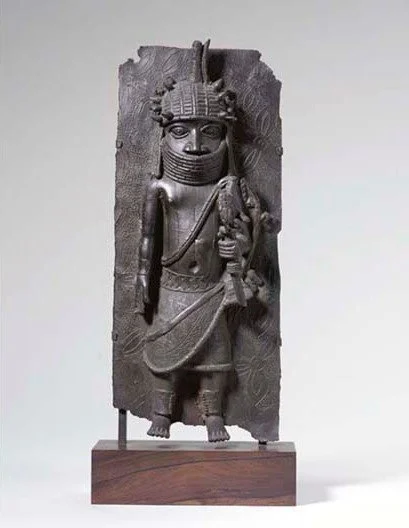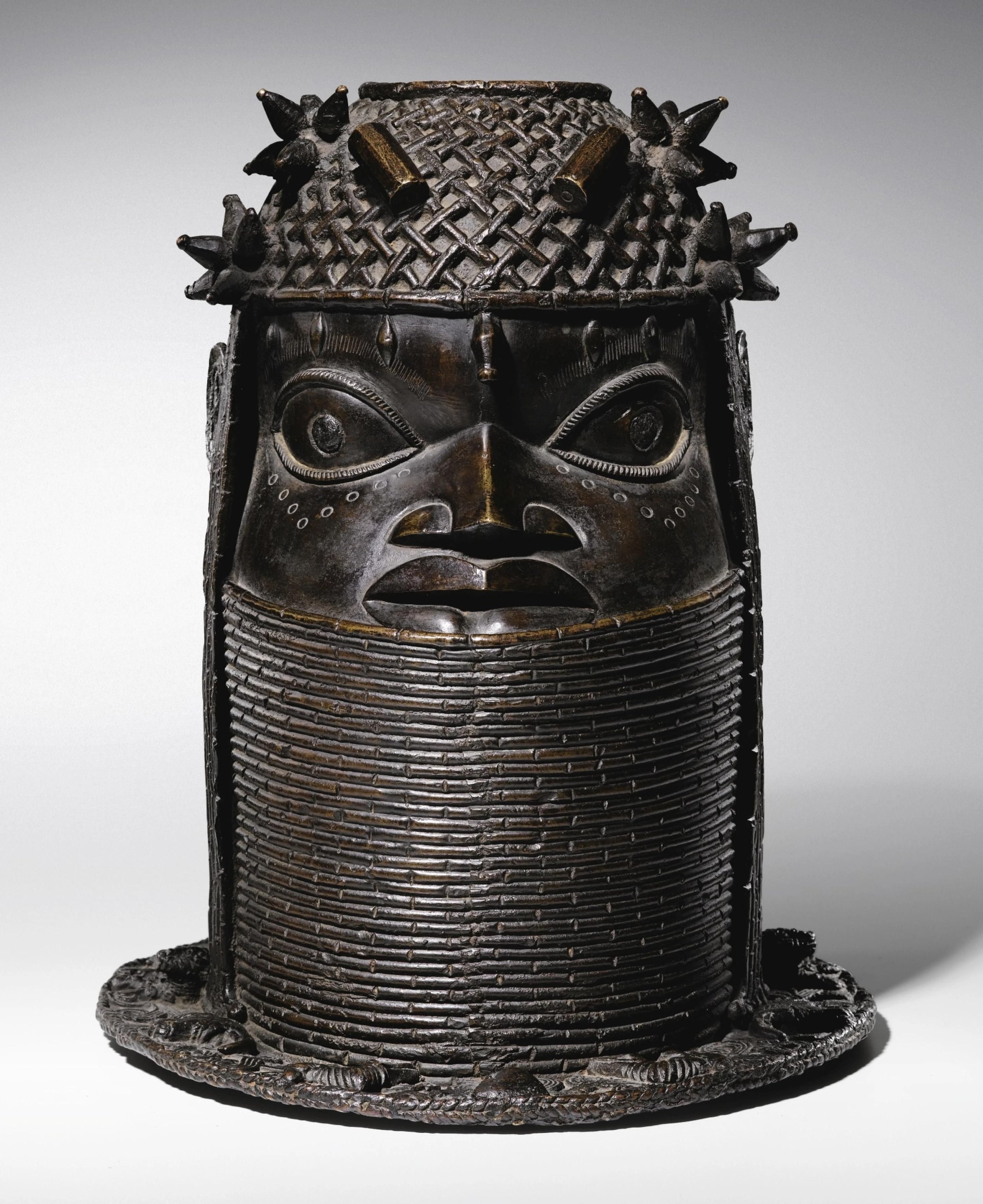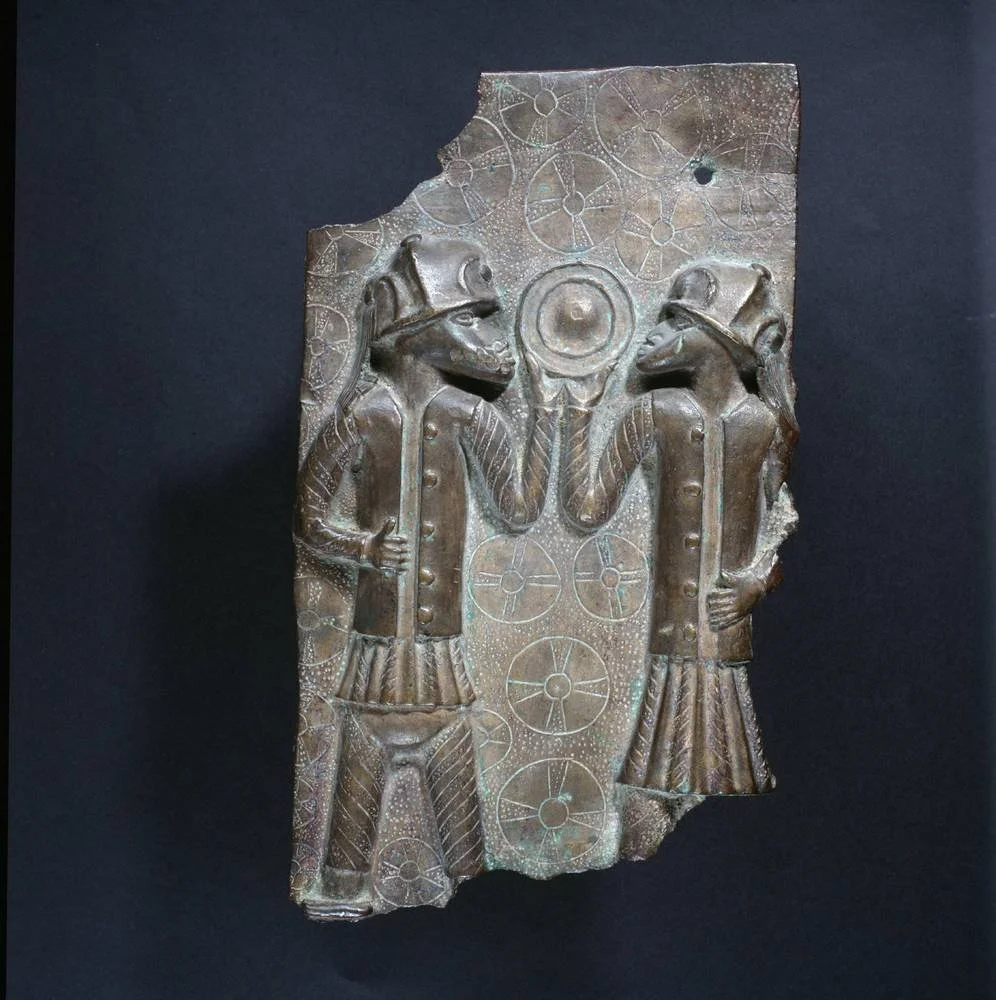Benin/Edo Plaque
Benin/Edo Plaque
Nigeria (former empire of Benin)
17th - 18th century
Copper Alloy. Dimensions: 19.75 x 12.75 in
Price: $835,000
Description
“The Edo Kingdom [of Benin] is situated in a tropical forest region of southern Nigeria. Oral traditions suggest that, by the thirteenth or fourteenth century, the Edo people were united into a powerful kingdom which, by the fifteenth century, had embarked on a course of aggressive military expansion in the region. During this period of conquest Portuguese explorers made contact with them, recording for the first time the name “Benin,” which has been used ever since to refer to the kingdom. For four hundred years Benin traded with the Portuguese and other European nations until, in 1897, it fell to British colonial expansion and was later incorporated into the wider political framework of Nigeria.”[1]
Our plaque depicts two Portuguese men holding “neptunes,” copper disks which the Portuguese traded for slaves, ivory, and other goods, and which, because of their value to the Benin royal metalsmithing guild, were used as currency among the Edo. The Portuguese were readily accepted in Benin: they represented the wealth and power the divine oba (king) was able to bring to his people,[2] (a fulfillment of the king’s association with the spirit of the sea, Olukun, bringer of wealth). The Portuguese were said to have provided troops for the conquest of the neighboring Igala kingdom during the reign of oba Esigie in the 16th century. Trade was mutually beneficial, and the Portuguese made no efforts to dislocate the king’s authority. Favorable representations of the Portuguese are well-documented, with the tradition of showing them in 16th or 17th century dress, often armed, helmeted, and long-haired.[3]
Plaques are a difficult subject, as the scholarship for where, when, and how many plaques exist seems to be somewhat conjectural. It is accepted that between 900 and 1000 plaques were ripped from the support posts in the royal palace during the British “Punitive Expedition” of 1897, (and that upwards of 3000--or 4000—total pieces went to England in either private or military hands).[4] But even very recent scholarship suggests that the palace plaques were rectangular and were of two sizes: those with side flanges, and those without side flanges.[5] So where does that leave an “oval or shield-shaped” plaque? “Relegated to pilasters in the galleries in the Benin royal palace, and as is probably the case here, on the doors to the building,”[6] obviously a best guess. In 1919, a researcher by the name of Felix von Luschan estimated that only 60 similar plaques existed, and possibly only 10 with this specific motif,[7] (2 Portuguese figures against a background dotted with small circled crosses) with only 2 presently accounted for--one at the Musee du Quai Branly, Paris, and one at the Museum fur Volkerkunde, Dresden. William Fagg, conservator for the plaques at the British Museum, concluded that the plaque now held at Quai Branly was the first of its kind, and ascribed it to “the Master of the Circled Cross,” working in the 16th century, or the middle period of Benin palatial art.[8]
Our plaque is very similar to the Quai Branly example, (see attached) with our casting exhibiting a little less detail along the buttons and collar of the tunics worn by the figures. The overall mood of the piece, with the two men of equal stature grasping a Neptune between them, seems to be rather egalitarian and fraternal. Ours is larger overall by about 4 inches in height and 1 inch in width, and it appears that our background may never have been intended to extend above and behind the heads of the figures. The “circled crosses” are more uniform and more tightly modelled in our example. Certainly the two are sister pieces, and if ours was not made by the same master, they are too similar to think that the composition had not become an accepted motif. On its own merits, this beautiful piece exemplifies the highest standards of the fabulously accomplished artistry of the Benin empire at its height.
Footnotes
[1] Schmalenbach, Werner ed., African Art: From the Barbier-Mueller Collection (Munich: Prestel, 1988). 137.
[2] Le Fur, Yves ed., Musee Du Quai Branly: Art From Africa, Asia, Oceania, and the Americas, Illustrated edition (Paris: Skira, 2009). 34.
[3] Visona, Monica Blackmu et al., A History of Art in Africa (New York: Prentice Hall/Harry N. Abrams, 2000). 323
[4] Obinyan, Thomas Uwadiale. “The Annexation of Benin,” Journal of Black Studies 19 (1) (1988): 29–40.
[5] Gunsch, Kathryn Wysocki. “The Benin Plaques : A Singular Monument.” Tribal Art 22 (3), no. 88 (Summer 2018): 98–113.
[6] Le Fur, Musee Du Quai Branly, 34.
[7] Le Fur, Musee Du Quai Branly, 34.
[8] Le Fur, Musee Du Quai Branly, 34.
Christie's
An Important Benin Bronze Plaque
Kingdom of Benin, Nigeria
16th century
Bronze
Height: 16 in
Christie's. “The Russell B. Aitken Collection of African, American: Live Auction 1278 3 April 2003, New York.” Lot 64.
Auction Estimate: 180,000 - 220,000 USD
Price Realized: 388,300 USD
(Photo: Christie's)
Sotheby's
Tête, Edo, Royaume de Benin
Kingdom of Benin, Nigeria
16th century
Bronze
Height: 12.375 in
Sotheby's. “Arts D'Afrique Et D'Océanie: Live Auction PF1718 12 December 2017, Paris.” Lot 67.
Auction Estimate: 600,000 - 900,000 EUR
Price Realized: 1,869,000 EUR
(Photo: Sotheby's)
Edo. Waist Pendant with Oba and Two Attendants
Benin City, Edo State, Nigeria.
mid-16th to early 17th century
Copper alloy.
Brooklyn Museum, Gift of Beatrice Riese.
(Photo: Brooklyn Museum)

Edo. Plaque with two Portuguese men
Benin City, Edo State, Nigeria.
16th century
Brass
15.5 x 11.5 x 2 in
Musée du Quai Branly.
(Photo: Le Fur, Yves. Musee Du Quai Branly: Art From Africa, Asia, Oceania, and the Americas. Skira Flammarion, 2009. 35.)
Relief Panel with Two Portuguese
Kingdom of Benin, Nigeria
Before 1897
Brass
31 x 18 x 2.5 cm
Museum of Ethnology Dresden
Inventory Number: 13597
(Photo: Museum of Ethnology Dresden)
Ben-Amos, Paula Gershick. The Art of Benin: Revised Edition. London: British Museum Press, 1995.
Fagg, William Buller, and Margaret Plass, eds. African Sculpture: An Anthology. Studio Vista, 1964.
Geary, Christraud M. “The Robert Owen Lehman Collection of Ancient West African Art at the Museum of Fine Arts Boston.” Tribal Art: Quarterly Journal of the Art Culture and History of Traditional Peoples and New World Civilizations 18 (1), no. 70 (Winter 3013): 80–89.
Gunsch, Kathryn Wysocki. “The Benin Plaques : A Singular Monument.” Tribal Art: Quarterly Journal of the Art Culture and History of Traditional Peoples and New World Civilizations 22 (3), no. 88 (Summer 2018): 98–113.
Le Fur, Yves. Musee Du Quai Branly: Art From Africa, Asia, Oceania, and the Americas. Illustrated edition. Paris: Skira, 2009.
Luschan, Felix von. Die Altertümer von Benin. Berlin: Staatliche Museen, 1919. https://www.si.edu/object/siris_sil_126211.
Newton, Douglas, and Tamara Northern, eds. Art of Oceania, Africa and the Americas from the Museum of Primitive Art. May-Aug. 1969. Catalogue by Douglas Newton, Tamara Northern, Robert Goldwater, Julie Jones. Metropolitan Museum of Art, 1969. https://resources.metmuseum.org/resources/metpublications/pdf/Art_of_Oceania_Africa_and_the_Americas_from_the_Museum_of_Primitive_Art.pdf.
Obinyan, Thomas Uwadiale. “The Annexation of Benin.” Journal of Black Studies 19 (1) (1988): 29–40.
Phillips, Tom, ed. Africa : The Art of a Continent. London: Prestel, 1996.
Plankensteiner, Barbara. Benin Kings and Rituals: Court Arts from Nigeria. Austria: Snoeck, 2007.
Robbins, Warren M., and Nancy Ingram Nooter. African Art in American Collections. Washington and London: Smithsonian Institution Press, 1989.
Schädler, Karl-Ferdinand. Encyclopedia of African Art and Culture. Munich: Panterra, 2009.
Schmalenbach, Werner, ed. African Art: From the Barbier-Mueller Collection. Munich: Prestel, 1988.
Siegmann, William C. African Art: A Century At The Brooklyn Museum. First Edition. Brooklyn, NY : Munich ; New York: Prestel, 2009.
Visona, Monica Blackmun, Robin Poynor, Herbert M. Cole, Michael D. Harris, Rowland Abiodun, and Suzanne Preston Blier. A History of Art in Africa. New York: Prentice Hall/Harry N. Abrams, 2000.




